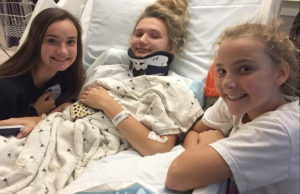Alternative school providing essential assistance for some
I have never had concrete plans for my life, but I never thought I would be attending the alternative program for my sophomore year of high school. The year had started off great — I was in the musical, I was preparing to audition for All-State choir and I was involved in a variety of extracurricular activities at Waverly Shell-Rock High School. I had great friends, a fantastic support system and many wonderful opportunities, but I was struggling.
I had been diagnosed with Major Depressive Disorder and Generalized Anxiety Disorder two years prior. I began taking medication in 2013 to keep my depression and anxiety under control. I was also seeing a therapist once a week to talk through my emotions and learn healthy coping skills.
During October of my sophomore year, it became more difficult to me to manage my mental illness. I was more depressed than I ever had been before; my anxiety was spiraling out of control, and it was getting harder and harder for me to stay in school. I was taking online classes, and my parents were talking to the administration about options for schooling. Life was becoming so much harder.
One of the administrators mentioned an alternative program, and I was very skeptical at first. I was worried of what my friends and classmates were going to think of me. It was a surprise to many people that I was struggling so badly with mental illness because many people weren’t able to tell. If I hadn’t have transferred to the alternative school during my sophomore year, I’m not sure how I would have finished, and I’m not the only one.
Isaiah Sigler, a graduate of the Cedar Falls High School Alternative Program, said that alternative programs were the best option for him as he was finishing up schooling. “I wasn’t really going to school, and the alternative school seemed like the best option.”
Sigler wasn’t attending school because of mental health struggles. “I’ve got social anxiety. Crowds really freak me out I guess.”
After meeting with his counselor, Sigler decided to make the transfer to the alternative program. “Mrs. Denholm was a huge help. It was off of her recommendation that I go to the alternative school that I actually started giving it serious thought.”
After thinking about whether to attend, Sigler made the decision to transfer. “I transferred about halfway through the first semester of this year, my senior year.”
Students who transfer in the middle of a semester may have to start their courses over again. “It’s a lot more self driven,” Sigler said. “You’re just sitting there at your own pace, but if you fall behind it’s all on you, but I feel like it made it easier. I felt more of a drive to do my work.”
The alternative program is very independent based and is hard to keep up for those who fall behind or don’t keep up with their work. “I would walk in, I’d sit down at my desk, I’d do my APEX for about an hour, we would read for an hour, I’d do my APEX for another hour and then I’d go home,” Sigler said. He took four APEX classes, which were core classes that were set up online. “The alternative program was most definitely the best fit for me,” he said.
Sigler was at first worried about the stigma that comes along with attending the alternative school, but by the time he started, his worries were gone. “I know there’s a stigma that goes along with going to the alternative school, like you feel like you’re going to be looked down upon for going there, but it’s a lot better environment for those with high anxiety,” he said. “If you need a different type of schooling, don’t feel bad about it.”
Dan Weichers, the counselor at the alternative program, was first a counselor at the Cedar Falls High School and then transferred over to the alternative program. “Our alternative program is designed to offer an educational experience to progress toward graduation for high school students in a small setting,” he said. There are typically 10-15 students in each of the two sections, and with a session in the morning and a session in the afternoon, students can either attend one session or the other.
“There are several educational opportunities available to students depending on the day and time of the year,” Weichers said. “For example, most of our students spend a good portion of their time learning math, science, social studies and English (core classes) through an online learning system called APEX.”
As well as working on APEX classes, students take part in field trips, listen to guest speakers, participate in PE and share life experiences in group time.
“Students are provided a schedule that may better fit their needs. Some students find the mostly online curriculum works well for their learning style, and the smaller scale learning environment is preferred by some,” Weichers said. “Some potential disadvantages could be less course offerings (electives), less ‘hands on’ learning, less social opportunities during the day and less direct instruction.”
As Sigler mentioned, Weichers also said that these advantages and disadvantages are also based on personal preference to learning styles.
Chris Wood, a counselor at the high school, helps students make the decision to transfer to the alternative program. “Typically the alternative program is for students that the regular high school environment isn’t the best fit for them,” he said
There are a variety of different reasons why the high school isn’t the best fit for some students. “Academically, socially, emotionally, for whatever reason, sometimes the high school doesn’t work, ” he said, and if the student is struggling at the high school, an alternative option is available. “There is a full staff out there that is willing to work with students, and the curriculum is all online.”
Because the learning is online based, it is up to the student to stay on top of their school work and make sure they’re on track. “When students make the transition out there, we let them know that it gives you the ability to finish your diploma, but it’s going to be a different educational experience,” Woods said.
A few years ago, students that weren’t struggling with the regular high school environment were wanting to transition over to the alternative program, but that’s not the process of how transferring to the alternative program works. “This, (the high school), is the number one place we want you to be, but if for whatever reason we get to a point where this isn’t working, then we start looking at what the transition out there looks like,” Woods said.
Although people do attend the alternative program for full days, there is the option of going for half days and the other half attending the high school. “We try and take steps to get to the point to go to the alternative program,” he said.
Typically, students don’t automatically transfer to the alternative program right away.
“When a student transfers in the middle of the semester, you start the classes there,” Woods said.This means that the student could be starting the course over, and this is something that is discussed between the counselor and the student on deciding which schooling option to take.“We try to do what’s in the best interest for the student, but also work well with the setting that they’re in.”
The alternative program provides a more one on one setting that works better for the student.
“The alternative program is pretty structured,” Woods said. “You have a time you need to show up every day, and if you don’t show up by that time, it counts as an absence. The attendance policy is pretty cut and dry.”
Just like the high school, Wood said it may or may not be a good fit for students. “I would say that the alternative program is more strict there than at the high school, but they are more lenient once you’re there,” Wood said. The staff works with the students, and it is a flexible program that is meant to help benefit the needs of the student. “It’s a small learning environment, but they do some great things because they adapt to the needs of the student.”
Because of the smaller learning environment, the staff is able to focus and cater to each of the students needs.
“When a student attends the alternative program, they are still a member of the Cedar Falls High School,” Wood said. The program is through the school, and is called the Cedar Falls High School Alternative Program.
It’s important that everyone understands that just because some students attend the alternative program rather than the traditional high school doesn’t mean that those students are unintelligent. The alternative program is a type of schooling that works better for some students, and it is unfortunate that there is a stigma surrounding this type of learning.
I hope that in the future, people will understand that alternative programs provides a one-on-one learning environment, offers flexible classes and acknowledge that mental health problems or other challenging circumstances are valid. The alternative program is a great resource for students who don’t feel comfortable or struggle in a traditional learning environment.









You must be logged in to post a comment Login